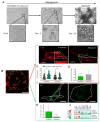Advanced Glycation End Products Effects on Adipocyte Niche Stiffness and Cell Signaling
- PMID: 36768583
- PMCID: PMC9917270
- DOI: 10.3390/ijms24032261
Advanced Glycation End Products Effects on Adipocyte Niche Stiffness and Cell Signaling
Abstract
Adipose tissue metabolism under hyperglycemia results in Type II diabetes (T2D). To better understand how the adipocytes function, we used a cell culture that was exposed to glycation by adding intermediate carbonyl products, which caused chemical cross-linking and led to the formation of advanced glycation end products (AGEs). The AGEs increased the cells and their niche stiffness and altered the rheological viscoelastic properties of the cultured cells leading to altered cell signaling. The AGEs formed concomitant with changes in protein structure, quantified by spectroscopy using the 8-ANS and Nile red probes. The AGE effects on adipocyte differentiation were viewed by imaging and evidenced in a reduction in cellular motility and membrane dynamics. Importantly, the alteration led to reduced adipogenesis, that is also measured by qPCR for expression of adipogenic genes and cell signaling. The evidence of alteration in the plasma membrane (PM) dynamics (measured by CTxB binding and NP endocytosis), also led to the impairment of signal transduction and a decrease in AKT phosphorylation, which hindered downstream insulin signaling. The study, therefore, presents a new interpretation of how AGEs affect the cell niche, PM stiffness, and cell signaling leading to an impairment of insulin signaling.
Keywords: AGEs; adipocytes; adipogenesis; carbonyl compounds; cell migration; cytoskeleton reorganization; niche stiffness; plasma-membrane stiffness.
Conflict of interest statement
The authors declare no conflict of interest.
Figures






Similar articles
-
Advanced glycation end-products regulate extracellular matrix-adipocyte metabolic crosstalk in diabetes.Sci Rep. 2019 Dec 24;9(1):19748. doi: 10.1038/s41598-019-56242-z. Sci Rep. 2019. PMID: 31875018 Free PMC article. Clinical Trial.
-
An advanced glycation end product (AGE)-receptor for AGEs (RAGE) axis restores adipogenic potential of senescent preadipocytes through modulation of p53 protein function.J Biol Chem. 2012 Dec 28;287(53):44498-507. doi: 10.1074/jbc.M112.399790. Epub 2012 Nov 13. J Biol Chem. 2012. PMID: 23150674 Free PMC article.
-
Oral advanced glycation endproducts (AGEs) promote insulin resistance and diabetes by depleting the antioxidant defenses AGE receptor-1 and sirtuin 1.Proc Natl Acad Sci U S A. 2012 Sep 25;109(39):15888-93. doi: 10.1073/pnas.1205847109. Epub 2012 Aug 20. Proc Natl Acad Sci U S A. 2012. PMID: 22908267 Free PMC article.
-
Advanced Glycation End Products and Diabetes Mellitus: Mechanisms and Perspectives.Biomolecules. 2022 Apr 4;12(4):542. doi: 10.3390/biom12040542. Biomolecules. 2022. PMID: 35454131 Free PMC article. Review.
-
Activation of the receptor for advanced glycation end products and consequences on health.Diabetes Metab Syndr. 2017 Oct-Dec;11(4):305-309. doi: 10.1016/j.dsx.2016.09.009. Epub 2016 Sep 4. Diabetes Metab Syndr. 2017. PMID: 27612394 Review.
Cited by
-
Receptor for the Advanced Glycation End Products (RAGE) Pathway in Adipose Tissue Metabolism.Int J Mol Sci. 2023 Jul 1;24(13):10982. doi: 10.3390/ijms241310982. Int J Mol Sci. 2023. PMID: 37446161 Free PMC article. Review.
-
(Patho)Physiology of Glycosylphosphatidylinositol-Anchored Proteins II: Intercellular Transfer of Matter (Inheritance?) That Matters.Biomolecules. 2023 Jun 15;13(6):994. doi: 10.3390/biom13060994. Biomolecules. 2023. PMID: 37371574 Free PMC article. Review.
-
Advanced glycation end-products accelerate amyloid deposits in adipocyte's lipid droplets.Cell Death Dis. 2024 Nov 19;15(11):846. doi: 10.1038/s41419-024-07211-6. Cell Death Dis. 2024. PMID: 39562539 Free PMC article.
-
The Advanced Glycation End-Products (AGE)-Receptor for AGE System (RAGE): An Inflammatory Pathway Linking Obesity and Cardiovascular Diseases.Int J Mol Sci. 2025 Apr 14;26(8):3707. doi: 10.3390/ijms26083707. Int J Mol Sci. 2025. PMID: 40332316 Free PMC article. Review.
-
Mechanism and implications of advanced glycation end products (AGE) and its receptor RAGE axis as crucial mediators linking inflammation and obesity.Mol Biol Rep. 2025 Jun 5;52(1):556. doi: 10.1007/s11033-025-10632-x. Mol Biol Rep. 2025. PMID: 40474023 Review.
References
-
- Briceno Noriega D., Zenker H.E., Croes C.A., Ewaz A., Ruinemans-Koerts J., Savelkoul H.F.J., van Neerven R.J.J., Teodorowicz M. Receptor Mediated Effects of Advanced Glycation End Products (AGEs) on Innate and Adaptative Immunity: Relevance for Food Allergy. Nutrients. 2022;14:371. doi: 10.3390/nu14020371. - DOI - PMC - PubMed
MeSH terms
Substances
LinkOut - more resources
Full Text Sources
Medical
Miscellaneous

